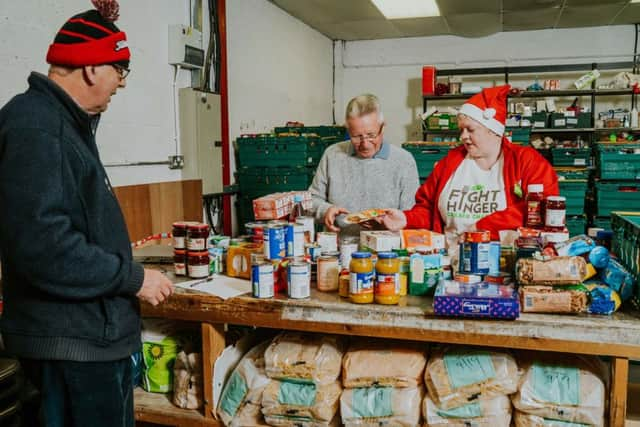How food banks are helping the hungry this Christmas


For people on the breadline, the festive season, with its unremitting television ads for plump turkeys, mince pies and food galore, can be an incredibly challenging time.
Across the UK food banks have fed more than 180,000 people since April 2012 and are multiplying at an astonishing rate.
Advertisement
Hide AdAdvertisement
Hide AdHere in Northern Ireland, thousands of people, young and old, will get their Christmas groceries from a food bank.


Dave Magill, Northern Ireland area manager for Trusell Trust, the anti-poverty charity which oversees the UK’s 292 food banks, said working with food banks is ‘‘simultaneously saddening, infuriating, uplifting and inspiring’’.
He said: ‘‘Working with people of such passion and commitment to serving and helping those in crisis in their community is humbling and challenging.’’
‘‘Engaging with the causes and reality of food poverty in 21st century Northern Ireland is shocking and crushing,’’ he added.
Advertisement
Hide AdAdvertisement
Hide AdMr Magill said last year, 32,000 people received food parcels from Trussell Trust food banks in Northern Ireland.


‘‘It’s just a number and I am used to sharing it; but I should never lose track of its meaning. With every number we count two stories are being told; the story of hunger and the story of hope.
‘‘Each food parcel that leaves one of our foodbanks tells the story of an individual or family who had fallen into hunger. It tells a story of someone brave enough to ask for help.
‘‘In a nation this wealthy the reality of that statistic breaks my heart. Each number counted tells a story of a crisis; real people, with real lives, real dreams, real pain and real feelings. When numbers get to a certain point we can lose track of the humanity behind them and the story they tell. We don’t see faces in statistics.
Advertisement
Hide AdAdvertisement
Hide Ad‘‘Yet each number tells a story of hope; that when one person fell into crisis others were there to help. For at the same time as these very real people, in very real crisis needed help, very real strangers bought an extra tin of vegetables, a bottle of UHT milk or a jar of peanut butter and put it in a collection basket.
‘‘At the same time as someone reached for help, others reached their hands out to welcome them to a food bank with a cup of tea, a smile and a biscuit.’’
Mr Magill added that the fact that food bank volunteers and donors are out there shines a little more light into the world.
‘‘Food poverty should not exist but it does, and I’m grateful for the 40,000-plus volunteers who hate its existence as much as I do but will stand in the gap and generously give for as long as it does exist. I’m blessed to get to spend my time with them. There are no big names, no bright lights but there are thousands of heroes.’’
Advertisement
Hide AdAdvertisement
Hide AdIt is often assumed food banks redistribute supermarket food (only 10% is given by them, 90% is through public donation). It is also commonly thought that they cater for the homeless (fewer than 5% of recipients are homeless).
They help the unemployed, working poor – and, increasingly, the middle classes. Nor do people turn up out of the blue. They are referred by frontline care professionals. And they are not fed indefinitely. This is crisis provision for three days; it does not encourage dependency.